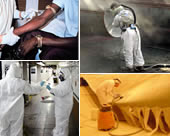| Abstract |
| In response to a request from the Brotherhood of Painters and Allied Trades of America, an investigation was begun into a possible hazard from carry home lead (7439921) containing dust during the removal of paint by George Campbell Painting Company, (SIC-1622), Groton, Connecticut. The company was renovating a two span highway bridge. Work had begun 4 months earlier and was to be finished in 36 months. Blood lead levels of the employees ranged from 2.2 to 16.5 micrograms/deciliter (microg/dl) with a mean of 7.2microg/dl. The 13 workers whose jobs took them near the containment structure had blood lead levels much higher than the nine workers whose jobs were less exposed. Those in job categories of blaster/painter, apprentice, and recycling equipment operator had much higher time weighted average exposures than the OSHA permissible exposure limit of 40 micrograms/cubic meter (microg/m3). In three samples taken for the blaster/painters, the personal breathing zone lead concentration exceeded 1,000microg/m3. Surface lead levels on skin, clothing and personal cars were determined. In each of the 27 cars tested, lead was detected, with the greatest concentrations being on the floor at the driver's feet, suggesting lead was carried on the shoes. The authors conclude that workers who entered areas where abrasive blasting took place were potentially exposed to lead. Workers may carry lead on their skin and clothes into their cars. The authors recommend that personal hygiene practices be used to reduce these exposures. |
|


